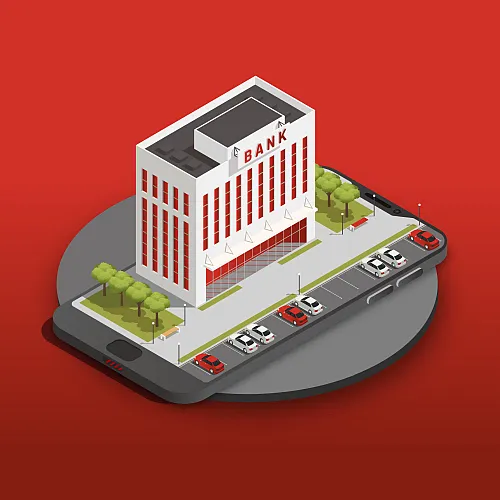What it takes to establish a digital bank?

Only 62 percent of the world’s population is banked, while 59.5 percent of the world uses the internet. With Fintech services dominating the economic sector, financial inclusivity has become possible even in the most remote corners of the world like Africa.
The evolution of computers and the internet fuelled the birth of digital banks and neobanks. The digital branches of traditional banks started appearing in the 1990s, and then smaller fintech start-ups providing digital-only banking services started germinating with the turn of the century.
The introduction of the iPhone expedited the progress of the fintech industry. In 2009, the world saw the launch of Simple, and Ally Bank. Simple is often regarded as the world’s first digital-only bank. Moven and Chime were the next entrants, and since 2015 the market has burgeoned exponentially.
The digital-only banking sector is estimated to grow at a Compound Annual Growth Rate (CAGR) of 46% and can amount to 356 million USD by 2025. There are over 300+ digital banks globally, and the number is growing rapidly every quarter.
Popular examples of neobanks are:
- Chime- USA
- Varo- USA
- Dave – USA
- Monzo – UK
- Revolut- UK
- N26- Germany
- SoFi- USA
- Robinhood- USA
- Klarna- Sweden
- NuBank – Brazil

The scope of neobanks and challenger banks in the African continent
57% of the entire African population, which roughly equals 95 million people are unbanked. Limited economic options, unstable banking, and poor public infrastructure lead to dire conditions. But as per the FDI report, 456 million phone users and an additional 167 million users will be added by 2025, and Africa has one of the fastest-growing smartphone markets.
Today, challenger banks and neobanks are infiltrating this landscape and bringing in more people under the umbrella of economic inclusivity. Digital P2P lending has helped remove obstacles of middleman and predatory lending and has been beneficial for the growth of SME sectors.
As per reports by EY, in the decade between 2009 and 2019, neobanks in Africa have grown by almost 24 percent. Nigeria, Kenya, and South Africa have shown the greatest development in this sector. The other countries showing steady progress are Kenya, Tunisia, Ivory Coast, and Tanzania, among others.
The African subcontinent and the sub-Saharan region were among the worst affected areas by the COVID-19 pandemic and a significantly low vaccination rate. This directly impacted the economic development of this region, and this blow can be cushioned by the emergence and dominance of open banking services like digital-only banks.
Some of the top African neobanks are:
- Fund
- Ever send
- Africa
- 7aweshly
- Carbon
- Kuda
- Tyme Bank
- Chipper Cash
- PiggyVest
- CowryWise
- Lidya
- SOL wallet
Digital-only banks vs traditional banks
Neobanks and challenger banks were created to plug the gap in the services that were lacking by old-school banks. The new age banking is more convenient, tailored, and customer-centric than high street banks, which have unmalleable rules and regulations, long queues, and often outdated technology.
We have compiled a table for easier understanding of the difference between these two financial systems:
| Metrics | Traditional Banks | Digital Banks |
| Service platform | Physical through bank branches | Digital platforms- websites and apps |
| Time period | Established more than a century ago | Established since turn off century |
| Customer support | In-person, via phone, emails. It is time-consuming. | Instant support through the app or online banking portals. CHatbot services. |
| Fees | Recurring cost | Nominal fees |
| Licensing | Fully licensed | None or partial licensure. Some banks function under umbrella licensing. |
| Branches | Multiple | None |
| Approval process | Lengthy | Instant and convenient |
| Customer reach | Limited | Wide-spread |
Today, digital banks (neobanks and challenger banks) are widely popular with impressive marketing techniques and asset-light and low-cost models. Still, a question that remains is the sustainability of this banking model? In African countries like Egypt, Nigeria, and others, incumbent banks didn’t have a strong presence due to a lack of infrastructural support. But with the successful implementation of digital banking, now people can readily access various financial services from the comfort of their phones.
Digital-only banks are gaining popularity in Africa, South America, and other parts of the world because:
- It is an AI-based, transparent banking system.
- Neobanks constantly innovates and provides customers with the same agility and convenience as other digital sectors.
- Neobanks have a wider customer base, concentrating on the unbanked population, ‘gig-economy,’ thin files, and MSMEs.
- By using AI and machine learning technology, neobanks have a more customer-centric approach.
How to create digital banks or neobanks from scratch?
1. Develop A Business Model
Create a proper business model, and some of the most effective neobanks models are:
- Interchange-led model
- Credit-led business model
- Ecosytem-led business model
- Asset-led business model
2. Technological Backbone
Firstly, you need to create the core back-end applications for a successful neobank platform/app. Things that need to be considered are:
- API
- Card processing tools
- Backend SaaS or BaaS software
Secondly, brands need to focus on developing the frontend of the application and concentrate on the UI/UX design. The app should be easily navigable and should include all the important features and services.
3. Create A Robust Security
The credibility of your platform lies on this, and you should have a double-layer of security infrastructure in place.
Run continuous tests to eradicate any bugs or lag in the software. Some of the critical tests that need to be run are:
- Unit-testing
- Integration testing
- Security testing
- User acceptance testing
- Regression testing
These tests need to be run even after the platform is live.
Future of digital banks in Africa
Neobanks and challenger banks have breathed a fresh lease of life into the African economic ecosystem. Even with such rapid development, of the world’s 300+ digital banks, only 20 are Africa-focussed.
Kuda and Tyme bank have emerged as industry leaders with millions of consumer bases. Today, these digital platforms are raising millions of dollars in funding, helping them strengthen their infrastructure and expand their clientele and repertoire.
AI-based credit-led neobanks have disbursed more than 300,000 million dollars’ worth of credit.
Technological advancements have helped a lot. Brands are revamping their in-house tech. There are also experienced third-party platforms like CIT Vericash, which offers a cutting-edge software platform that enables a collaborative ecosystem of mobile financial services, enabling financial inclusion in emerging markets. With multiple services on offer, digital banks can use their advanced tech to boost their market penetration further.
CIT VERICASH has established its end-end digital banking platform, offering all incumbent banks and new digital-only banks, the possibility of having a universal seamless platform covering everything from all the backend operational functions to the digital front channels all streamlined to address a unique customer experience across channels and that enables them to consume the different digital financial services innovatively and with minima frictions offered across the multiple touchpoints.
Final Words
African neobanks have reached a high level of maturity in providing digital solutions to local communities and cross-border offers to the global diaspora. Despite their rapid growth, African neobanks have obstacles in their development. In most countries, enabling legislation and infrastructure for fintech firms are still in their infancy.
Finding the appropriate balance and alignment between regional regulators, the fintech sector, and the youth will be crucial for the collective to succeed in their market transformation quest.
About CIT Vericash
CIT VERICASH is a division of CIT GLOBAL, an international leading provider of innovative eCommerce and mCommerce software solutions and services with solid expertise spanning 25 years, since its establishment in Toronto, Canada in 1993. By applying CIT Global’s dedicated centers of excellence and its specialized leading products, in cooperation with its strategic partners, the company has delivered innovative and award-winning solutions to its clients in more than 48 countries, serving leading brands from North America, Europe, Asia Pacific, the Middle East, and Africa.


